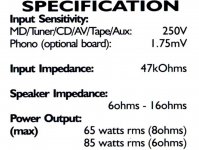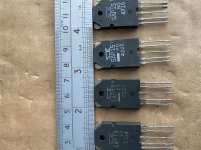Hallo DIYers
Yesterday i had the experience of my trusty A500 amp out of nowhere, driving 4 ohm speakers, suddenly having the right channel dying completely.
Not longer than 30 minutes later, the left channel died as well.
Two red diodes have lit up inside the cabinet, nothing other than that looks out of the ordinary.
Does anyone know what the next step in finding the problem here and if its fixable?
I hurried out and bought a NAD320BEE to replace it, as i had no other amp at that specific time, but i would very much like to bring back the A500, as it had a great sound and many solid qualities to it.
Should i visit a technician about this?
Thanks alot, you HiFi wizards!
Yesterday i had the experience of my trusty A500 amp out of nowhere, driving 4 ohm speakers, suddenly having the right channel dying completely.
Not longer than 30 minutes later, the left channel died as well.
Two red diodes have lit up inside the cabinet, nothing other than that looks out of the ordinary.
Does anyone know what the next step in finding the problem here and if its fixable?
I hurried out and bought a NAD320BEE to replace it, as i had no other amp at that specific time, but i would very much like to bring back the A500, as it had a great sound and many solid qualities to it.
Should i visit a technician about this?
Thanks alot, you HiFi wizards!
Hello, thanks for the reminder
I knew beforehand that it was specifically not meant to drive 4 ohm speakers, but it has done so beautifully for months now.
Also, ive read somewhere that it generally isnt a problem for the amp at all anyhow, but yeah, maybe it actually is.
Do you have an idea what part ive possibly toasted then, is the whole amp toasted for good?
Thanks, Nicolai
I knew beforehand that it was specifically not meant to drive 4 ohm speakers, but it has done so beautifully for months now.
Also, ive read somewhere that it generally isnt a problem for the amp at all anyhow, but yeah, maybe it actually is.
Do you have an idea what part ive possibly toasted then, is the whole amp toasted for good?
Thanks, Nicolai
Sounds like the failure mechanism is secondary breakdown due to the higher current peaks - 4 ohm nominal speakers can be significantly less than 4 ohms across resonance as well, so even a 5Vrms signal could be pulling 3A peak, with most of the supply rails still across the output devices - note this is happening well below max drive levels.
With 8 ohm the same power level would be 7Vrms, peak current about a half as much with less voltage across the outputs, about 40% as much stress to the outputs.
With 8 ohm the same power level would be 7Vrms, peak current about a half as much with less voltage across the outputs, about 40% as much stress to the outputs.
I knew beforehand that it was specifically not meant to drive 4 ohm speakers, but it has done so beautifully for months now.
Award winning!
The red diodes are LEDs used as voltage references, and they should be lit.
Almost certainly the SAP devices have failed - this was a common issue with them!
A good option for the technician that does the repair for you is to use the Sanken STD devices, these are the same as the SAP's but without the problematic built in emitter resistor that fails. External emitter resistors can be added, and the result is much more reliable
Almost certainly the SAP devices have failed - this was a common issue with them!
A good option for the technician that does the repair for you is to use the Sanken STD devices, these are the same as the SAP's but without the problematic built in emitter resistor that fails. External emitter resistors can be added, and the result is much more reliable
Ill try take it to an electronics engineer sometime in the future, im simply a DIY speaker enthusiast/hobbyist ^^ Thanks for your input
The image in post 9 shows how the replacements would be laid out. The suffixes O and P indicate the hfE group. You need to match the suffix types so you have P suffixes in one channel and O in the other.
I checked one of the sources for replacement parts I mentioned earlier and the images for these indicate that only O suffix types are available.
The hFE for P suffix types is higher so you could take that as a plus in terms of what choices you have.
- Status
- This old topic is closed. If you want to reopen this topic, contact a moderator using the "Report Post" button.
- Home
- Amplifiers
- Solid State
- Cambridge A500 Sudden Death

